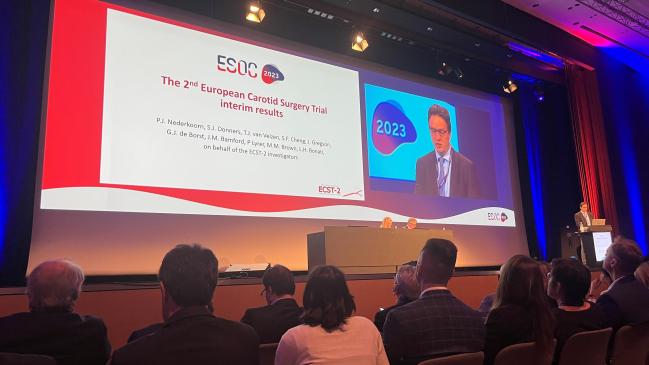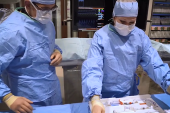ECST-2: No Benefit of Carotid Revascularization on Top of Best Medical Therapy
A more-definitive answer awaits with CREST-2, however, and this should provide momentum to get it done, one expert says.

MUNICH, Germany—Among patients with a carotid stenosis of at least 50% and a low-to-intermediate risk of stroke, adding carotid revascularization—mostly with endarterectomy—to optimal medical therapy doesn’t seem to make a difference in outcomes, interim results of the randomized ECST-2 trial suggest.
Through 2 years, the rate of a composite of periprocedural death, stroke, or MI was 10.3% with medical therapy alone and 10.0% with the combination of medical therapy and carotid revascularization, a nonsignificant difference (HR 0.96; 95% CI 0.53-1.76), Paul Nederkoorn, MD, PhD (Amsterdam UMC, the Netherlands), reported here at the European Stroke Organisation Conference (ESOC).
The findings were consistent regardless of whether patients were symptomatic or asymptomatic.
“There was no evidence of benefit at 2 years from additional carotid revascularization,” Nederkoorn said.
Commenting for TCTMD, Seemant Chaturvedi, MD (University of Maryland School of Medicine, Baltimore), noted that this is the second moderately sized trial, after SPACE-2, that failed to show a clear benefit of surgical revascularization in patients with carotid stenosis on top of modern medical therapy.
But he added that CREST-2, essentially two parallel trials comparing either carotid stenting or endarterectomy against optimal medical therapy in patients with asymptomatic carotid stenosis, is still ongoing. Expected to have about 2,500 patients, that will provide a more-definitive assessment of carotid revascularization’s impact in the current era of drug treatment.
“Some people might say that if you were a betting man, then CREST-2 might show similar results [to ECST-2], but we don’t know exactly because that has a much larger population and it’s going to be in North America predominantly,” said Chaturvedi, who is on the CREST-2 executive committee. “So I think you could say that maybe the CREST-2 results will be similar, but we’ll have to wait and see.”
In the meantime, he said, “this should give the CREST-2 investigators more momentum to finish the enrollment and the follow-up, because I think it’ll be very valuable for the medical community to get this data sooner rather than later.”
The ECST-2 Trial
Current guidelines for carotid endarterectomy are based on robust trial evidence, but those studies were done two to three decades ago, Nederkoorn said. Since then, major advances in medical therapy have cut the risk of stroke in half.
Whether carotid revascularization with stenting or endarterectomy is needed on the background of improving drug treatments in patients with asymptomatic carotid stenosis has been debated for years, with many pinning their hopes for an answer on CREST-2, which launched in 2014.
But ECST-2, conducted across 30 centers in Europe and Canada, provides some clues. Initially designed for 2,000 patients, recruitment was suspended after 429 (mean age about 72 years; 31% women) were enrolled, both to allow for a planned interim analysis and to devise a path forward for the study. It had become clear that reaching the planned enrollment was no longer practical, and there were difficulties with funding, Nederkoorn said.
All patients had an atherosclerotic carotid stenosis of 50% or greater and a low-to-intermediate estimated risk of stroke over the next 5 years, defined as Carotid Artery Risk (CAR) score of less than 20%. Roughly 40% of the study cohort was symptomatic, and the rest were asymptomatic.
All patients received optimal medical therapy with cholesterol-lowering medications and antihypertensives, as well as antiplatelets and anticoagulants as indicated, aiming for the following specific goals:
- Total cholesterol < 4.0 mmol/L
- LDL cholesterol < 2.0 mmol/L
- Blood pressure ≤ 135/85 mm Hg for patients younger than 80
- Blood pressure ≤ 150/90 mm Hg for patients 80 and older
In the intervention group, revascularization was mostly done with endarterectomy, although carotid stenting was allowed in select patients. The procedure was recommended within 2 weeks of randomization in symptomatic patients and within 4 weeks in asymptomatic patients.
Full 2-year data were not yet available, so Nederkoorn presented interim results.
For the primary composite outcome, the curves separated early—favoring medical therapy alone—and then came back together by 2 years. The same trends were seen for stroke, with no significant difference between the medical therapy and revascularization arms at that time point (6.0% vs 8.1%; HR 0.68; 95% CI 0.32-1.42).
There was only one periprocedural death in the trial (in the revascularization group), and MI was numerically but nonsignificantly higher among the patients who received medical therapy alone (4.9% vs 2.5%; HR 2.00; 95% CI 0.68-5.84).
Due to small numbers, no solid conclusions could be drawn from subgroup analyses, Nederkoorn said, but he added that there were no significant differences in any of the subgroups.
More Work to Do
Chaturvedi indicated that the findings were not entirely unexpected.
“I’ve been saying for 10-plus years that the improvements in medical therapy [are] going to decrease the stroke rate in medically treated patients and that’s going to decrease the need for carotid revascularization,” he said.
He added that more details are needed on the perioperative complication rate of carotid endarterectomy and on the average achieved LDL cholesterol and blood pressure, which should be available once the results are published.
Asked what messages can be taken away from these interim results, Chaturvedi noted that prior studies have shown that certain patient groups—women, patients whose events were more than 2 weeks ago, and patients with retinal versus brain events, for instance—derive less benefit from surgery. “So I think the ECST-2 data would support the fact that in some of these patients, we should be very comfortable treating them with intensive medical therapy only.”
Chaturvedi is leading a registry in the US called SCORE to study how well the groups that don’t do as well with surgery fare when they’re treated with intensive medical therapy.
Nederkoorn said his group continues to work on ECST-2, noting that the final 2-year results will incorporate an assessment of silent brain infarcts on MRI and a win-ratio analysis. Patients will be followed out to 5 years, and that longer follow-up is needed to see how the outcome curves evolve over time, he added.
Moreover, he said his group will design and validate a stroke prediction rule that takes into account MRI plaque imaging, with the idea that this could help select patients with a particularly high risk for revascularization.
Todd Neale is the Associate News Editor for TCTMD and a Senior Medical Journalist. He got his start in journalism at …
Read Full BioSources
Nederkoorn PJ. The 2nd European Carotid Surgery Trial: 2-year interim results. Presented at: ESOC 2023. May 25, 2023. Munich, Germany.
Disclosures
- ECST-2 was funded by the National Institute for Health and Care Research, the Swiss National Science Foundation, the Netherlands Organisation of Scientific Research, and the Leeds Neurology Foundation.
- Nederkoorn reports no relevant conflicts of interest.
- Chaturvedi reports being on the executive committee for the CREST-2 trial.





Comments